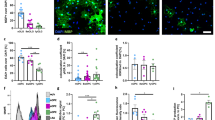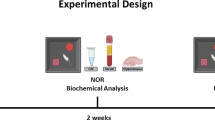Abstract
Formation of nitric oxide (NO), by astrocytes, has been suggested to contribute, via impairment of mitochondrial function, to the neurodegnerative process. Thus co-culture of neuronal cells with NO–generating astrocytes leads to a loss of mitochondrial function, as reflected by diminished activities of complexes IV and II+III. However, such damage may in the first instance be limited due to upregulation of neuronal glutathione metabolism as a result of metabolic trafficking of glutathione from the astrocyte to neurone. Furthermore, exposure of astrocytes to NO leads to increased glutathione metabolism resulting in the preservation of glutathione precursors for neuronal utilization. Failure of glutathione trafficking could render neuronal cells particularly susceptible to NO, leading to cell death. In addition, depletion with time of the nitric oxide synthase cofactor, tetrahydrobiopterin, may result in the astrocytic generation of more potent oxidizing species, which could contribute to the neurodegenerative process.
Similar content being viewed by others
References
Knowles, R. G. and Moncada, S. 1994. Nitric oxide synthases in mammals. Biochem. J. 298:249–258.
Murphy, S., Simmons, M. L., Agullo, L., Garcia, A., Feinstein, D. I., Galea, E., Reis, D. J., Minc-Golomb, D., and Schwartz, J. P. 1993. Synthesis of nitric oxide in CNS glial cells. Trends Neurosci. 16:323–328.
Bolanos, J. P., Peuchen, S., Heales, S. J., Land, J. M., and Clark, J. B. 1994. Nitric oxide-mediated inhibition of the mitochondrial respiratory chain in cultured astrocytes. J. Neurochem. 63:910–916.
Hevel, J. M. and Marletta, M. A. 1992. Macrophage nitric oxide synthase: Relationship between enzyme-bound tetrahydrobiopterin and synthase activity. Biochemistry 31:7160–7165.
Vega-Agapito, V., Almeida, A., Hatzoglou, M., and Bolanos, J. P. 2002. Peroxynitrite stimulates L-arginine transport system y(+) in glial cells: A potential mechanism for replenishing neuronal L-arginine. J. Biol. Chem. 277:29753–29759.
Sakai, N., Kaufman, S., and Milstien, S. 1995. Parallel induction of nitric oxide and tetrahydrobiopterin synthesis by cytokines in rat glial cells. J. Neurochem. 65:895–902.
Brown, G. C., Bolanos, J. P., Heales, S. J., and Clark, J. B. 1995. Nitric oxide produced by activated astrocytes rapidly and reversibly inhibits cellular respiration. Neurosci. Lett. 193:201–204.
Lipton, S. A., Choi, Y. B., Pan, Z. H., Lei, S. Z., Chen, H. S., Sucher, N. J., Losealzo, J., Singel, D. J., Stamler, J. S. 1993. A redox-based mechanism for the neuroprotective and neurodestructive effects of nitric oxide and related nitroso-compounds. Nature 364:626–632.
Boveris, A. and Chance, B. 1973. The mitochondrial generation of hydrogen peroxide: General properties and effect of hyperbaric oxygen. Biochem. J. 134:707–716.
Hunot, S., Boissiere, E., Faucheux, B., Brugg, B., Mouatt-Prigent, A., Agid, Y., and Hirsch, E. C. 1996. Nitric oxide synthase and neuronal vulnerability in Parkinson's disease. Neuroscience 72:355–363.
Shergill, J. K., Cammack, R., Cooper, C. E., Cooper, J. M., Mann, V. M., and Schapira, A. H. 1996. Detection of nitrosyl complexes in human substantia nigra, in relation to Parkinson's disease. Biochem. Biophys. Res. Commun. 12:298–305.
Good, P. F., Hsu, A., Werner, P., Perl, D. P., and Olanow, C. W. 1998. Protein nitration in Parkinson's disease. J. Neuropathol. Exp. Neurol. 57:338–342.
Giasson, B. I., Duda, J. E., Murray, J. V., Chen, Q., Souza, J. M., Hurtig, H. I., Ischiropoulos, H., Trojanowski, J. Q., and Lee, V. M. 2000. Oxidative damage linked to neurodegeneration by selective alpha-synuclein nitration in synucleinopathy lesions. Science 290:985–989.
Qureshi, G. A., Baia, S. M., and Parvez, S. 1998. Neurotoxicity and possible roles of aspartic acid, glutamic acid and GABA in some neurological disorders. Biogenic Amines 13:565–568.
Schapira, A. H., Cooper, J. M., Dexter, D., Clark, J. B., Jenner, P., and Marsden, C. D. 1990. Mitochondrial complex I deficiency in Parkinson's disease. J. Neurochem. 54:823–827.
Bywood, P. T. and Johnson, S. M. 2003. Mitochondrial complex inhibitors preferentially damage substantia nigra dopamine neurons in rat brain slices. Exp. Neurol. 79:47–59.
Jenner, P., Dexter, D. T., Sian, J., Schapira, A. H., and Marsden, C. D. 1992. Oxidative stress as a cause of nigral cell death in Parkinson's disease and incidental Lewy body disease: The Royal Kings and Queens Parkinson's Disease Research Group. Ann. Neurol. 32:S82–S87.
Heales, S. J. and Bolanos, J. P. 2002. Impairment of brain mitochondrial function by reactive nitrogen species: The role of glutathione in dictating susceptibility. Neurochem. Int. 40:469–474.
Smith, M. A., Richey Harris, P. L., Sayre, L. M., Beckman, J. S., and Perry, G. 1997. Widespread peroxynitrite-mediated damage in Alzheimer's disease. J. Neurosci. 17:2653–2657.
Vodovotz, Y., Lucia, M. S., Flanders, K. C., Chesler, L., Xie, O. W., Smith, T. W., Weidner, J., Mumford, R., Webber, R., Nathan, C., Roberts, A. B., Lippa, C. F., and Sporn, M. B. 1996. Inducible nitric oxide synthase in tangle-bearing neurons of patients with Alzheimer's disease. J. Exp. Med. 184:1425–1433.
Luth, H. J., Munch, G., and Arendt, T. 2002. Aberrant expression of NOS isoforms in Alzheimer's disease is structurally related to nitrotyrosine formation. Brain Res. 953:135–143.
Kish, S. J., Bergeron, C., Rajput, A., Dozic, S., Mastrogiacomo, E., Chang, L. J., Wilson, J. M., DiStefano, L. M., and Nobrega, J. N. 1992. Brain cytochrome oxidase in Alzheimer's disease. J. Neurochem. 59:776–779.
Canevari, L., Clark, J. B., and Bates, T. E. 1999. Beta-amyloid fragment 25–35 selectively decreases complex IV activity in isolated mitochondria. FEBS Lett. 457:131–134.
Casley, C. S., Canevari, L., Land, J. M., Clark, J. B., and Sharpe, M. A. 2002. Beta-amyloid inhibits integrated mitochondrial respiration and key enzyme activities. J. Neurochem. 80:91–100.
Keilin, D. and Hartree, E. F. 1939. Cytochrome and cytochrome oxidase. Proc. R. Soc. Lond. B Biol. Sci. 127:167–191.
Brown, G. C. and Cooper, C. E. 1994. Nanomolar concentrations of nitric oxide reversibly inhibit synaptosomal respiration by competing with oxygen at cytochrome oxidase. FEBS Lett. 356:295–298.
Radi, R., Beckman, J. S., Bush, K. M., and Freeman, B. A. 1991. Peroxynitrite-induced membrane lipid peroxidation: The cytotoxic potential of superoxide and nitric oxide. Arch. Biochem. Biophys. 288:481–487.
Paradies, G., Petrosillo, G., Pistolese, M., and Ruggiero, F. M. 2000. The effect of reactive oxygen species generated from the mitochondrial electron transport chain on the cytochrome c oxidase activity and on the cardiolipin content in bovine heart submitochondrial particles. FEBS Lett. 466:323–326.
Heales, S. J., Bolanos, J. P., Land, J. M., and Clark, J. B. 1994. Trolox protects mitochondrial complex IV from nitric oxide-mediated damage in astrocytes. Brain Res. 668:243–245.
Bolanos, J. P., Heales, S. J., Land, J. M., and Clark, J. B. 1995. Effect of peroxynitrite on the mitochondrial respiratory chain: Differential susceptibility of neurones and astrocytes in primary culture. J. Neurochem. 64:1965–1972.
Bolanos, J. P., Heales, S. J., Peuchen, S., Barker, J. E., Land, J. M., and Clark, J. B. 1996. Nitric oxide-mediated mitochondrial damage: A potential neuroprotective role for glutathione. Free Radic. Biol. Med. 21:995–1001.
Cassina, A. and Radi, R. 1996. Differential inhibitory action of nitric oxide and peroxynitrite on mitochondrial electron transport. Arch. Biochem. Biophys. 328:309–316.
White, D. A. 1973. The phospholipid composition of mammalian tissues. Pages 441–482, in Ansell, G. B., Hawthorne, J. N., Dawson, R. M. C. (Eds), Form and Function of phospholipids, Vol 3. Elsevier, Amsterdam.
Brookes, P. S., Land, J. M., Clark, J. B., and Heales, S. J. 1998. Peroxynitrite and brain mitochondria: Evidence for increased proton leak. J. Neurochem. 70:2195–2202.
Barker, J. E., Bolanos, J. P., Land, J. M., Clark, J. B., and Heales, S. J. 1996. Glutathione protects astrocytes from peroxynitrite-mediated mitochondrial damage: Implications for neuronal/astrocytic trafficking and neurodegeneration. Dev. Neurosci. 18:391–396.
Rahman, S., Hargreaves, I., Clayton, P., and Heales, S. 2001. Neonatal presentation of coenzyme Q10 deficiency. J. Pediatr. 139:456–458.
Mitrovic, B., Ignarro, L. J., Montestruque, S., Smoll, A., and Merrill, J. E. 1994. Nitric oxide as a potential pathological mechanism in demyelination: Its differential effects on primary glial cells in vitro. Neuroscience 61:575–585.
Almeida, A., Almeida, J., Bolanos, J. P., and Moncada, S. 2001. Different responses of astrocytes and neurons to nitric oxide: The role of glycolytically generated ATP in astrocyte protection. Proc. Natl. Acad. Sci. USA 98:15294–15299.
Gegg, M. E., Beltran, B., Salas-Pino, S., Bolanos, J. P., Clark, J. B., Moncada, S., and Heales, S. J. 2003. Differential effect of nitric oxide on glutathione metabolism and mitochondrial function in astrocytes and neurones: Implications for neuroprotection/neurodegneration. J. Neurochem. 86:228–237.
Dringen, R., Pfeiffer, B., and Hamprecht, B. 1999. Synthesis of the antioxidant glutathione in neurons: Supply by astrocytes of CysGly as precursor for neuronal glutathione. J. Neurosci. 19:562–569.
Hirrlinger, J., Schulz, J. B., and Dringen, R. 2002. Glutathione release from cultured brain cells: Multidrug resistance protein 1 mediates the release of GSH from rat astroglial cells. J. Neurosci. Res. 69:318–326.
Dringen, R., Gutterer, J. M., Gros, C., and Hirrlinger, J. 2001. Aminopeptidase N mediates the utilization of the GSH precursor CysGly by cultured neurons. J. Neurosci. Res. 66:1003–1008.
Stewart, V. C., Stone, R., Gegg, M. E., Sharpe, M. A., Hurst, R. D., Clark, J. B., and Heales, S. J. 2002. Preservation of extracellular glutathione by an astrocyte derived factor with properties comparable to extracellular superoxide dismutase. J. Neurochem. 83:984–991.
Stewart, V. C., Land, J. M., Clark, J. B., and Heales, S. J., 1998. Pretreatment of astrocytes with interferon-alpha/beta prevents neuronal mitochondrial respiratory chain damage. J. Neurochem. 70:432–443.
Stewart, V. C., Sharpe, M. A., Clark, J. B., and Heales, S. J. 2000. Astrocyte-derived nitric oxide causes both reversible and irreversible damage to the neuronal mitochondrial respiratory chain. J. Neurochem. 75:694–700.
Cosentino, F., Barker, J. E., Brand, M. P., Heales, S. J., Werner, E. R., Tippins, J. R., West, N., Channon, K. M., Volpe, M., and Luscher, T. F. 2001. Reactive oxygen species mediate endothelium-dependent relaxations in tetrahydrobiopterin-deficient mice. Arterioscler. Thromb. Vasc. Biol. 21:496–502.
Heales, S. J., Blair, J. A., Meinschad, C., and Ziegler, I. 1988. Inhibition of monocyte luminol-dependent chemiluminescence by tetrahydrobiopterin, and the free radical oxidation of tetrahydrobiopterin, dihydrobiopterin and dihydroneopterin. Cell Biochem. Funct. 6:191–195.
Barford, P. A., Blair, J. A., Eggar, C., Hammon, C., Morar, C., and Whitburn, S. B. 1984. Tetrahydrobiopterin metabolism in the temporal lobe of patients dying with senile dementia of Alzheimer type. J. Neurol. Neurosurg. Psychiatry 47:736–738.
Lovenburg, W., Levine, R. A., Robinson, D. S., Ebert, M., Williams, A. C., and Calne, D. B. 1979. Hydroxylase cofactor activity in cerebrospinal fluid of normal subjects and patients with Parkinson's disease. Science 204:624–626.
Delgado-Esteban, M., Almeida, A., and Medina, J. M. 2002. Tetrahydrobiopterin deficiency increases neuronal vulnerability to hypoxia. J. Neurochem. 82:1148–1159.
Author information
Authors and Affiliations
Corresponding author
Rights and permissions
About this article
Cite this article
Heales, S.J.R., Lam, A.A.J., Duncan, A.J. et al. Neurodegeneration or Neuroprotection: The Pivotal Role of Astrocytes. Neurochem Res 29, 513–519 (2004). https://doi.org/10.1023/B:NERE.0000014822.69384.0f
Issue Date:
DOI: https://doi.org/10.1023/B:NERE.0000014822.69384.0f




